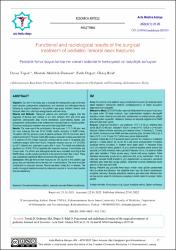| dc.contributor.author | Toprak, Duran | |
| dc.contributor.author | Özdemir, Mustafa Abdullah | |
| dc.contributor.author | Doğar, Fatih | |
| dc.contributor.author | Bilal, Ökkeş | |
| dc.date.accessioned | 2022-09-30T13:02:15Z | |
| dc.date.available | 2022-09-30T13:02:15Z | |
| dc.date.issued | 2022 | en_US |
| dc.identifier.uri | https://dergipark.org.tr/tr/download/article-file/2088577 | |
| dc.identifier.uri | https://hdl.handle.net/20.500.12868/1745 | |
| dc.description.abstract | Objective: Our aim in this study was to evaluate the demographic data on femoral
neck fractures, postoperative complications, and functional and radiological results
following its surgical treatment in the pediatric age group. Pediatric femoral neck
fractures often occur after high-energy trauma and seen rarely.
Material and Methods: Twenty-six patients who underwent surgery after the
diagnosis of femoral neck fracture in our clinic between 2012 and 2019 were
examined. Demographic data, trauma mechanism, accompanying injuries, and
postoperative complications of the patients were recorded from our registry system.
Functional radiological evaluation was performed using Ratliff criteria.
Results: The mean age of the participants in the study was 11.11 (3–16) year, and
the mean follow-up time was 29.34 (12-60) months. According to Ratliff criteria,
18 patients (69.2%) achieved good, 6 patients achieved (23.1%) moderate, and 2
patients achieved (7.7%) poor results after surgery. Avascular necrosis was observed
in 5 patients (19.2%) in total. Avascular necrosis did not occur in 10 patients who
underwent surgery within first 6 hours. Avascular necrosis occurred in 5 (31.25%)
out of 11 patients who underwent surgery after 6 hours. This result was statistically
significant (p = 0.049). Of the 5 patients with avascular necrosis, 3 were female and
2 were male. The clinical and radiological results were evaluated according to the
Ratliff criteria, and the results were found to be worse in females than in men. There
was a statistically significant difference between the genders (p=0.029).
Conclusion: Although femoral neck fractures are rare injuries in the pediatric age
group, they are important due to the high risk of complications. The most important
complication is avascular necrosis. Results are better males than in females. The
results of surgical treatments aimed at anatomical reduction in the shortest possible
time are satisfactory | en_US |
| dc.language.iso | eng | en_US |
| dc.publisher | Acta Medica Alanya | en_US |
| dc.relation.isversionof | 10.30565/medalanya.1025510 | en_US |
| dc.rights | info:eu-repo/semantics/openAccess | en_US |
| dc.subject | Femoral neck fracture | en_US |
| dc.subject | Pediatric | en_US |
| dc.subject | Avascular necrosis | en_US |
| dc.subject | Delbert classification | en_US |
| dc.title | Functional and radiological results of the surgical treatment of pediatric femoral neck fractures | en_US |
| dc.type | article | en_US |
| dc.contributor.department | ALKÜ | en_US |
| dc.identifier.volume | 6 | en_US |
| dc.identifier.issue | 1 | en_US |
| dc.identifier.startpage | 21 | en_US |
| dc.identifier.endpage | 26 | en_US |
| dc.relation.journal | Acta Medica Alanya | en_US |
| dc.relation.publicationcategory | Makale - Ulusal Hakemli Dergi - Başka Kurum Yazarı | en_US |


















